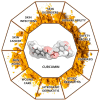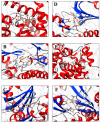Potential of Curcumin in Skin Disorders
- PMID: 31509968
- PMCID: PMC6770633
- DOI: 10.3390/nu11092169
Potential of Curcumin in Skin Disorders
Abstract
Curcumin is a compound isolated from turmeric, a plant known for its medicinal use. Recently, there is a growing interest in the medical community in identifying novel, low-cost, safe molecules that may be used in the treatment of inflammatory and neoplastic diseases. An increasing amount of evidence suggests that curcumin may represent an effective agent in the treatment of several skin conditions. We examined the most relevant in vitro and in vivo studies published to date regarding the use of curcumin in inflammatory, neoplastic, and infectious skin diseases, providing information on its bioavailability and safety profile. Moreover, we performed a computational analysis about curcumin's interaction towards the major enzymatic targets identified in the literature. Our results suggest that curcumin may represent a low-cost, well-tolerated, effective agent in the treatment of skin diseases. However, bypass of limitations of its in vivo use (low oral bioavailability, metabolism) is essential in order to conduct larger clinical trials that could confirm these observations. The possible use of curcumin in combination with traditional drugs and the formulations of novel delivery systems represent a very promising field for future applicative research.
Keywords: antioxidants; atopic dermatitis; curcumin; iatrogenic dermatitis; inflammaging; inflammatory skin diseases; molecular docking; psoriasis; skin aging; skin cancer; skin infections; wound care.
Conflict of interest statement
The authors report no conflicts of interest in this work.
Figures





Similar articles
-
Evidence of curcumin and curcumin analogue effects in skin diseases: A narrative review.J Cell Physiol. 2019 Feb;234(2):1165-1178. doi: 10.1002/jcp.27096. Epub 2018 Aug 2. J Cell Physiol. 2019. PMID: 30073647 Review.
-
Potential of Curcumin in the Management of Skin Diseases.Int J Mol Sci. 2024 Mar 23;25(7):3617. doi: 10.3390/ijms25073617. Int J Mol Sci. 2024. PMID: 38612433 Free PMC article. Review.
-
Curcumin: a novel treatment for skin-related disorders.J Drugs Dermatol. 2013 Oct;12(10):1131-7. J Drugs Dermatol. 2013. PMID: 24085048 Review.
-
Unraveling the Curcumin's Molecular Targets and Its Potential in Suppressing Skin Inflammation Using Network Pharmacology and In Vitro Studies.Drug Dev Res. 2025 Feb;86(1):e70058. doi: 10.1002/ddr.70058. Drug Dev Res. 2025. PMID: 39943799
-
Potential Role of Curcumin Against Biofilm-Producing Organisms on the Skin: A Review.Phytother Res. 2017 Dec;31(12):1807-1816. doi: 10.1002/ptr.5912. Epub 2017 Sep 7. Phytother Res. 2017. PMID: 28884496 Review.
Cited by
-
Obstacles against the Marketing of Curcumin as a Drug.Int J Mol Sci. 2020 Sep 10;21(18):6619. doi: 10.3390/ijms21186619. Int J Mol Sci. 2020. PMID: 32927725 Free PMC article. Review.
-
Ethosomes for Curcumin and Piperine Cutaneous Delivery to Prevent Environmental-Stressor-Induced Skin Damage.Antioxidants (Basel). 2024 Jan 11;13(1):91. doi: 10.3390/antiox13010091. Antioxidants (Basel). 2024. PMID: 38247515 Free PMC article.
-
Wrinkle reduction using a Sasang constitutional medicine-based topical herbal cream in So-eum subjects: A split-face randomized double-blind placebo-controlled study.Integr Med Res. 2022 Mar;11(1):100752. doi: 10.1016/j.imr.2021.100752. Epub 2021 Jun 23. Integr Med Res. 2022. PMID: 34345586 Free PMC article.
-
Exploring the polarization of M1 and M2 macrophages in the context of skin diseases.Mol Biol Rep. 2024 Feb 1;51(1):269. doi: 10.1007/s11033-023-09014-y. Mol Biol Rep. 2024. PMID: 38302766 Review.
-
Photodegradation of Turmeric Oleoresin Under Fluorescent Light and White LED: Impacts on the Chemical Stability, Bioactivity, and Photosensitizing Property of Curcuminoids.Molecules. 2025 Jul 30;30(15):3187. doi: 10.3390/molecules30153187. Molecules. 2025. PMID: 40807362 Free PMC article.
References
-
- Farzaei M.H., Zobeiri M., Parvizi F., El-Senduny F.F., Marmouzi I., Coy-Barrera E., Naseri R., Nabavi S.M., Rahimi R., Abdollahi M. Curcumin in Liver Diseases: A Systematic Review of the Cellular Mechanisms of Oxidative Stress and Clinical Perspective. Nutrients. 2018;10:855. doi: 10.3390/nu10070855. - DOI - PMC - PubMed
-
- Signh Khasla K.P., Tierra M. The Way of Ayurvedic Herbs. Lotus Press; Twin Lakes, WI, USA: 2008.
-
- Skenderi G. Herbal Vade Mecum Rutherford. Herbacy Press; Rutherford, NJ, USA: 2003.
Publication types
MeSH terms
Substances
LinkOut - more resources
Full Text Sources
Medical

